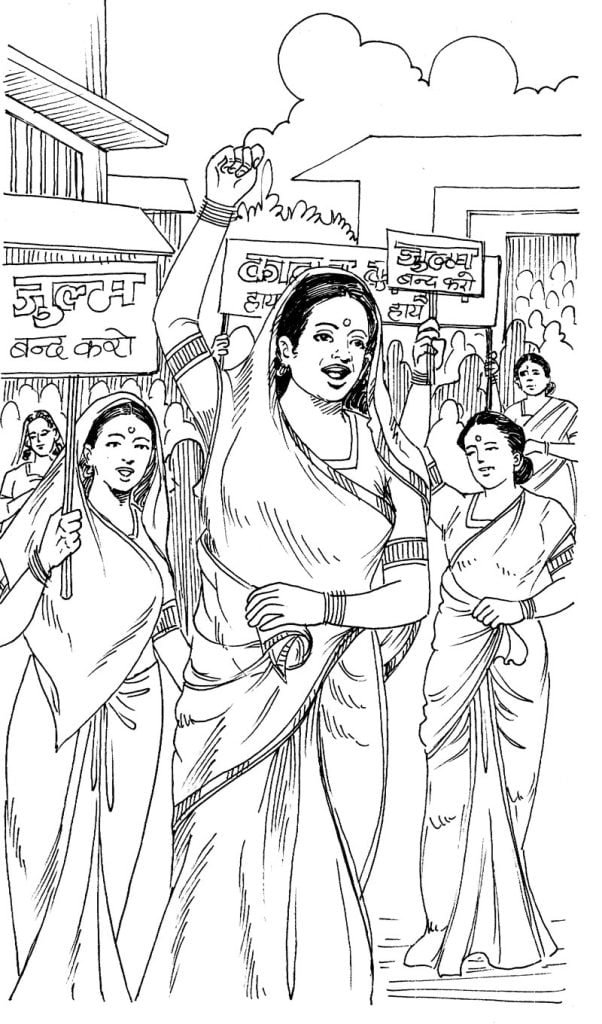Kasturba was the better half of the father of nation, Mahatma Gandhi. She was an ideal Indian wife. Besides being the inspiration of Gandhiji she was herself a great patriot and an example of the spirit of sacrifice. She was the woman behind Gandhiji.
Her father Gokuldas Manakji was a prosperous businessman. A 12 year old Kasturba was married to Mohandas Gandhi who also was of the same age. The families were reasonably well off, hence Mohandas continued to study even after marriage.
Kasturba had got no school education. Mohandas taught her Hindi and Gujrati at home. After graduation Mohandas went to England for further studies in law. Kasturba stayed back at home and led a normal event free life.
The revolution in Kasturba’s life came with her husband, Mohandas Gandhi. She was traditionally true, faithful, generous and religious wife. Although she was a docile woman yet when some threat came to their self respect or honour she fought like a lioness. Her husband had gone to South Africa in connection with a legal case. There colour racialism was prevalent as a state policy. Mohandas Gandhi fought legal cases and on the side started, movement against the policy of the colour apartheid. A large number of Indians had been taken there to work as labourers basically. They and the local black people were being treated like animals by the white European rulers.
Mohandas wrote a letter to Kasturba about the situation there and the injustice of the white racialists. That took Kasturba to her husband in South Africa. The couple started the battle against apartheid. It was the first non-violent movement against a repressive regime in the world. For 18 years Gandhis remained in South Africa and continued their fight non-violently called ‘Satyagraha’ against the policies of white racial regime. The epic non-violent movement ‘Satyagraha’ made Mohandas ‘Mahatma Gandhi’ and Kasturba became ‘Ba’ out of respect of the people.

Gandhiji’s battle against apartheid proved a living education for ‘Ba’ who learnt politics, social science and politicial movements through it.
According to apartheid rules every Indian there had to provide full information on his family to police, report to police station every week, marry in church only, any marriage done in Indian or African customs had to be redone in a Church to have children officially accepted as legal. In Satyagraha movement against above policies thousands went to jail including its author Mohandas Gandhi. It was imprisonment without bail or trial.
Kasturba could no more remain confined to her house only providing moral support to her man. To meet the challenge she came out and took charge of the movement as all the men were in jails. Ba rallied the womenfolk and continued the battle. The racialist regime’s police had to arrest her along with hundreds of other women and imprison them. In jail ‘Ba’ started hunger strike in protest against mistreatment, bad diet and lack of basic facilities. The jail authorities put pressure on her to break her fast but she stood her ground and refused to eat. Her digestive system went out of gear and her physical condition became precarious. The authorities had to release her on health grounds.
For 6-7 years more Gandhiji and Ba stayed in Africa and carried on their campaign. The white regime had to take back black laws one by one. Their movement was totally non-violent and non-cooperation with the repressive regime was the basic element. With Indian immigrants the local negros also started to take part in those movements. A string of political leadership had come up through non-violent movements. In 1915 Gandhis returned to homeland having delivered the Indians from racial injustices of the white regime. Later, Nelson Mandela continued the movement against whites treading the path shown by Gandhiji and finally succeeded in banishing apartheid. South Africa still retains fond and grateful memories of the Gandhis who set it on the road to freedom from racial discrimination.
In India, Gandhi toured the country to understand its grass root problems and causes of slavery. To cities, towns and villages they went and studied situations and the mindsets to work out strategies for freedom struggle.
Seeing people die of hunger and poverty, Kasturba once remarked, “They don’t have any work. If they just spin yarn on wheels, they will get clothing to cover themselves and earn some money by selling yarn to buy foodgrains.”
This simple remark of Ba got etched in the mind of Mahatma Gandhi and the idea of Khadi movement was born. Gandhiji made spinning wheel his weapon to fight the colonial rulers. It led to boycott of foreign cloths and weaving yarn became a freedom movement exercise. Generally the people think Khadi movement to be the brain child of Gandhiji but it was the sacrifice and simplicity of Ba that seeded the idea.
In the course of freedom movement when Gandhis were jailed they were put up in grand Agha Khan Palace of Poona instead of ordinary jail to deny them company of others. Kasturba fell ill and on February 22, 1944 she left for her heavenly abode.
The authorities did not allow her body to be taken out of Palace for proper funeral. Ba was cremated inside Agha Khan Palace complex. The British were afraid to release her dead body even.
Can an inspirational soul kept prisoner forever. ‘No’ is the answer. That is why only five years after the death of Ba the British had to leave India and grant the natives freedom.
Whenever we think of the father of nation today Ba also comes to mind as a natural backdrop.

